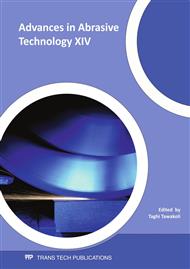[1]
R.W. Smith, R. Novak: Advances and applications in U.S. thermal spray technology. In: Powder Metallurgy International, Vol. 23, No. 4, pp.231-236, (1991).
Google Scholar
[2]
H. Haferkamp, K. Lindemann, M. Deutschmann, V. Thoms, R. Müller: Verschleiß bei Umformwerkzeugen reduzieren. In: wt Werkstattstechnik online, No. 11/12, pp.591-594, (2002).
DOI: 10.37544/1436-4980-2002-11-12-591
Google Scholar
[3]
M. Deutschmann: Lasergestützte Herstellung von Keramik-Stahl-Werkstoffverbundschichten für Werkzeuge der Blechumformung. Dr. -Ing. Dissertation, Leibniz Universität Hannover, (2007).
Google Scholar
[4]
K. Weinert, D. Biermann, M. Liedschulte: Drilling of magnesium matrix composites. In: Production Engineering. Research and Development, Vol. 6, No. 1, pp.15-20, (1999).
Google Scholar
[5]
K. Weinert, D. Biermann, S. Bergmann: Machining of high strength lightweight alloys for engine applications. In: CIRP Annals, Vol. 56, No. 1, pp.105-108, (2007).
DOI: 10.1016/j.cirp.2007.05.027
Google Scholar
[6]
E. Uhlmann, R. Kott, C. Hübert: Wear mechanisms of mono- and multi-layer CVD diamond films. In: Production Engineering. Research and Development, Vol. 11, No. 2, pp.83-86, (2004).
Google Scholar
[7]
F. H. Sun, X. K. Li, Y. Wang, M. Chen: Studies on the grinding characteristics of SiC particle reinforced aluminum-based MMCs. In. Key Engineering Materials, Vol. 304/305, p.261'265, (2006).
DOI: 10.4028/www.scientific.net/kem.304-305.261
Google Scholar
[8]
B. Denkena, J.C. Becker, D. Boehnke, M. Stahl: Schleifbearbeitung von Verbunden aus Stahl und Keramik. In: 14. Symposium Verbundwerkstoffe und Werkstoffverbunde, 2. -4. Juli 2003, Wien, Hrsg.H. -P. Degischer, pp.708-713, (2003).
DOI: 10.1002/9783527609017.ch116
Google Scholar
[9]
B. Denkena, M. Reichstein, A. Karyazin: Wear Behavior of Vitrified Bonded Grinding Wheels During Ceramic Steel Compound Machining. In: Production Engineering. Research and Development, Vol. 13, No. 2, pp.67-70, (2006).
Google Scholar
[10]
T. Lierse: Mechanische und thermische Wirkungen beim Schleifen keramischer Werkstoffe. Dr. -Ing. Dissertation, Universität Hannover, (1998).
Google Scholar
[11]
H. K. Tönshoff, B. Denkena: Spanen, Springer-Verlag, 2. Auflage, Hannover (2004).
Google Scholar


